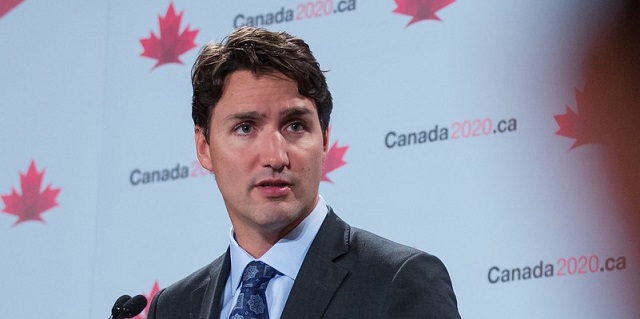Economy
Federal government consistently spends beyond high spending targets

From the Fraser Institute
By Matthew Lau
Post-pandemic, the Liberals raised annual spending by nearly $100 billion versus their pre-pandemic fiscal plan.
As budget season approaches, one thing is clear. If the Trudeau government is notable for planning astonishingly high levels of spending, it’s equally notable for overspending beyond its original plans. At all times—when they first took office in 2015, in the pre-pandemic years, and now—the Liberals have consistently raised their spending targets, then spent more than targeted.
Begin at the beginning. Inheriting a projected balanced budget in 2015, the Liberals proceeded to spend federal finances into deficit in the 2015-16 fiscal year (ended March 31, 2016) before presenting the first budget of their own in the spring of 2016. That budget called for $1,219 billion in program spending over the next four years. What the government actually ended up spending was $1,269 billion for the 2016-17 to 2019-20 fiscal years, blowing past their initial plan by a cumulative $50 billion.
Even worse, they set government spending on a higher trajectory—while cumulative spending in the Liberals’ first four full fiscal years in office was 4.1 per cent more than initially planned, the spending level for fiscal year 2019-20 alone was actually 11.1 per cent above the original target. So not only did the Liberals overspend their Budget 2016 fiscal plan by $50 billion over four years, they significantly weakened the fiscal outlook by permanently raising baseline spending for future years.
That federal program spending exploded to $624 billion in 2020-21 from $349 billion in 2019-20 is not surprising given the onetime expenses during the pandemic, and the $479 billion in spending in 2021-22 also included pandemic-related costs. But while some COVID spending was justifiable, much of the new spending was not. According to an analysis by Fraser Institute economists, $360 billion in pandemic-related spending, at least 25 per cent was unnecessary waste.
What about after the pandemic? In post-pandemic fiscal year 2022-23, program spending was $448 billion and debt interest expenses $35 billion, for a total of $483 billion. Compare that to what the Liberals initially planned in Budget 2018, the earliest fiscal plan to project out to 2022-23. Budget 2018, itself no model of fiscal responsibility, planned $350 billion in program spending and $33 billion in debt interest costs for a total of $383 billion (excluding a $3 billion “adjustment for risk”) in 2022-23.
So post-pandemic, the Liberals raised annual spending by nearly $100 billion versus their pre-pandemic fiscal plan. Comparing expected spending for 2023-24 with the plan in Budget 2019 shows a similar discrepancy. The 2023 Fall Economic Statement projects $450 billion in program spending and $496 billion in total spending versus $369 billion in program spending and $402 billion in total spending for 2023-24 in the Liberals’ 2019 fiscal plan (which itself contained material upward spending revisions from Budget 2018).
Speaking of the Fall Economic Statement, it also revised the spending trajectory upward from what the Liberals budgeted in the spring. In Budget 2023, the Liberals projected $2,395 billion in program spending over the next five fiscal years—or $2,630 billion including interest expenses. Because of new spending commitments and higher borrowing costs, five-year program spending is now expected to be $2,422 billion ($28 billion higher) and total spending $2,688 billion ($58 billion higher).
That’s a significant spending plan increase in only half a year. However, given the Trudeau government’s track record of missing its targets, don’t be surprised if actual spending comes in even higher than the latest forecast.
Author:
Business
The great policy challenge for governments in Canada in 2026

From the Fraser Institute
According to a recent study, living standards in Canada have declined over the past five years. And the country’s economic growth has been “ugly.” Crucially, all 10 provinces are experiencing this economic stagnation—there are no exceptions to Canada’s “ugly” growth record. In 2026, reversing this trend should be the top priority for the Carney government and provincial governments across the country.
Indeed, demographic and economic data across the country tell a remarkably similar story over the past five years. While there has been some overall economic growth in almost every province, in many cases provincial populations, fuelled by record-high levels of immigration, have grown almost as quickly. Although the total amount of economic production and income has increased from coast to coast, there are more people to divide that income between. Therefore, after we account for inflation and population growth, the data show Canadians are not better off than they were before.
Let’s dive into the numbers (adjusted for inflation) for each province. In British Columbia, the economy has grown by 13.7 per cent over the past five years but the population has grown by 11.0 per cent, which means the vast majority of the increase in the size of the economy is likely due to population growth—not improvements in productivity or living standards. In fact, per-person GDP, a key indicator of living standards, averaged only 0.5 per cent per year over the last five years, which is a miserable result by historic standards.
A similar story holds in other provinces. Prince Edward Island, Nova Scotia, Quebec and Saskatchewan all experienced some economic growth over the past five years but their populations grew at almost exactly the same rate. As a result, living standards have barely budged. In the remaining provinces (Newfoundland and Labrador, New Brunswick, Ontario, Manitoba and Alberta), population growth has outstripped economic growth, which means that even though the economy grew, living standards actually declined.
This coast-to-coast stagnation of living standards is unique in Canadian history. Historically, there’s usually variation in economic performance across the country—when one region struggles, better performance elsewhere helps drive national economic growth. For example, in the early 2010s while the Ontario and Quebec economies recovered slowly from the 2008/09 recession, Alberta and other resource-rich provinces experienced much stronger growth. Over the past five years, however, there has not been a “good news” story anywhere in the country when it comes to per-person economic growth and living standards.
In reality, Canada’s recent record-high levels of immigration and population growth have helped mask the country’s economic weakness. With more people to buy and sell goods and services, the overall economy is growing but living standards have barely budged. To craft policies to help raise living standards for Canadian families, policymakers in Ottawa and every provincial capital should remove regulatory barriers, reduce taxes and responsibly manage government finances. This is the great policy challenge for governments across the country in 2026 and beyond.
Business
Dark clouds loom over Canada’s economy in 2026

From the Fraser Institute
The dawn of a new year is an opportune time to ponder the recent performance of Canada’s $3.4 trillion economy. And the overall picture is not exactly cheerful.
Since the start of 2025, our principal trading partner has been ruled by a president who seems determined to unravel the post-war global economic and security order that provided a stable and reassuring backdrop for smaller countries such as Canada. Whether the Canada-U.S.-Mexico trade agreement (that President Trump himself pushed for) will even survive is unclear, underscoring the uncertainty that continues to weigh on business investment in Canada.
At the same time, Europe—representing one-fifth of the global economy—remains sluggish, thanks to Russia’s relentless war of choice against Ukraine, high energy costs across much of the region, and the bloc’s waning competitiveness. The huge Chinese economy has also lost a step. None of this is good for Canada.
Yet despite a difficult external environment, Canada’s economy has been surprisingly resilient. Gross domestic product (GDP) is projected to grow by 1.7 per cent (after inflation) this year. The main reason is continued gains in consumer spending, which accounts for more than three-fifths of all economic activity. After stripping out inflation, money spent by Canadians on goods and services is set to climb by 2.2 per cent in 2025, matching last year’s pace. Solid consumer spending has helped offset the impact of dwindling exports, sluggish business investment and—since 2023—lacklustre housing markets.
Another reason why we have avoided a sharper economic downturn is that the Trump administration has, so far, exempted most of Canada’s southbound exports from the president’s tariff barrage. This has partially cushioned the decline in Canada’s exports—particularly outside of the steel, aluminum, lumber and auto sectors, where steep U.S. tariffs are in effect. While exports will be lower in 2025 than the year before, the fall is less dramatic than analysts expected 6 to 8 months ago.
Although Canada’s economy grew in 2025, the job market lost steam. Employment growth has softened and the unemployment rate has ticked higher—it’s on track to average almost 7 per cent this year, up from 5.4 per cent two years ago. Unemployment among young people has skyrocketed. With the economy showing little momentum, employment growth will remain muted next year.
Unfortunately, there’s nothing positive to report on the investment front. Adjusted for inflation, private-sector capital spending has been on a downward trajectory for the last decade—a long-term trend that can’t be explained by Trump’s tariffs. Canada has underperformed both the United States and several other advanced economies in the amount of investment per employee. The investment gap with the U.S. has widened steadily since 2014. This means Canadian workers have fewer and less up-to-date tools, equipment and technology to help them produce goods and services compared to their counterparts in the U.S. (and many other countries). As a result, productivity growth in Canada has been lackluster, narrowing the scope for wage increases.
Preliminary data indicate that both overall non-residential investment and business capital spending on machinery, equipment and advanced technology products will be down again in 2025. Getting clarity on the future of the Canada-U.S. trade relationship will be key to improving the business environment for private-sector investment. Tax and regulatory policy changes that make Canada a more attractive choice for companies looking to invest and grow are also necessary. This is where government policymakers should direct their attention in 2026.
-

 Haultain Research19 hours ago
Haultain Research19 hours agoTrying to Defend Maduro’s Legitimacy
-

 Energy22 hours ago
Energy22 hours agoThe U.S. Just Removed a Dictator and Canada is Collateral Damage
-

 Business1 day ago
Business1 day agoVacant Somali Daycares In Viral Videos Are Also Linked To $300 Million ‘Feeding Our Future’ Fraud
-

 International22 hours ago
International22 hours agoU.S. Claims Western Hemispheric Domination, Denies Russia Security Interests On Its Own Border
-

 International1 day ago
International1 day ago“Captured and flown out”: Trump announces dramatic capture of Maduro
-

 International1 day ago
International1 day agoTrump Says U.S. Strike Captured Nicolás Maduro and Wife Cilia Flores; Bondi Says Couple Possessed Machine Guns
-

 International22 hours ago
International22 hours agoUS Justice Department Accusing Maduro’s Inner Circle of a Narco-State Conspiracy
-

 International19 hours ago
International19 hours ago“It’s Not Freedom — It’s the First Step Toward Freedom”












